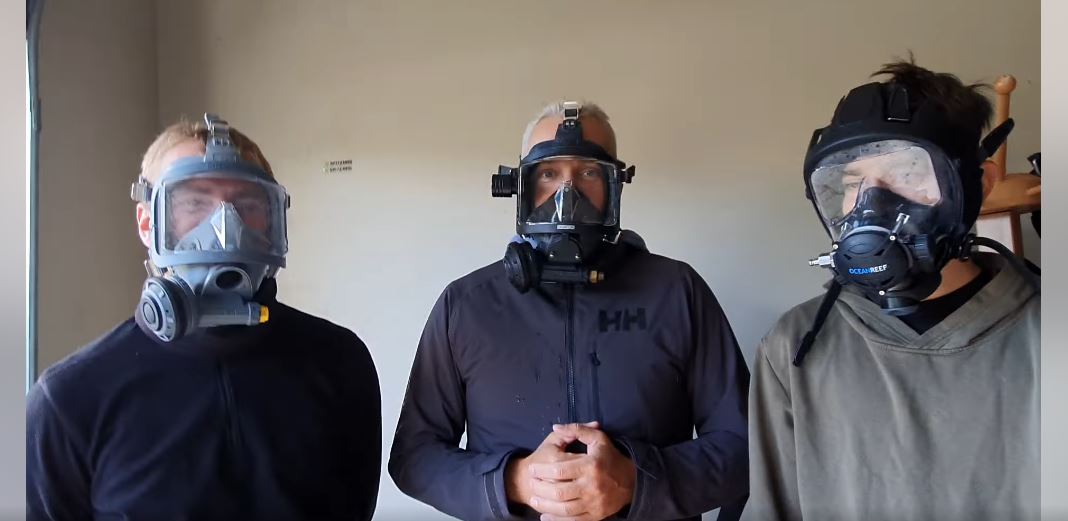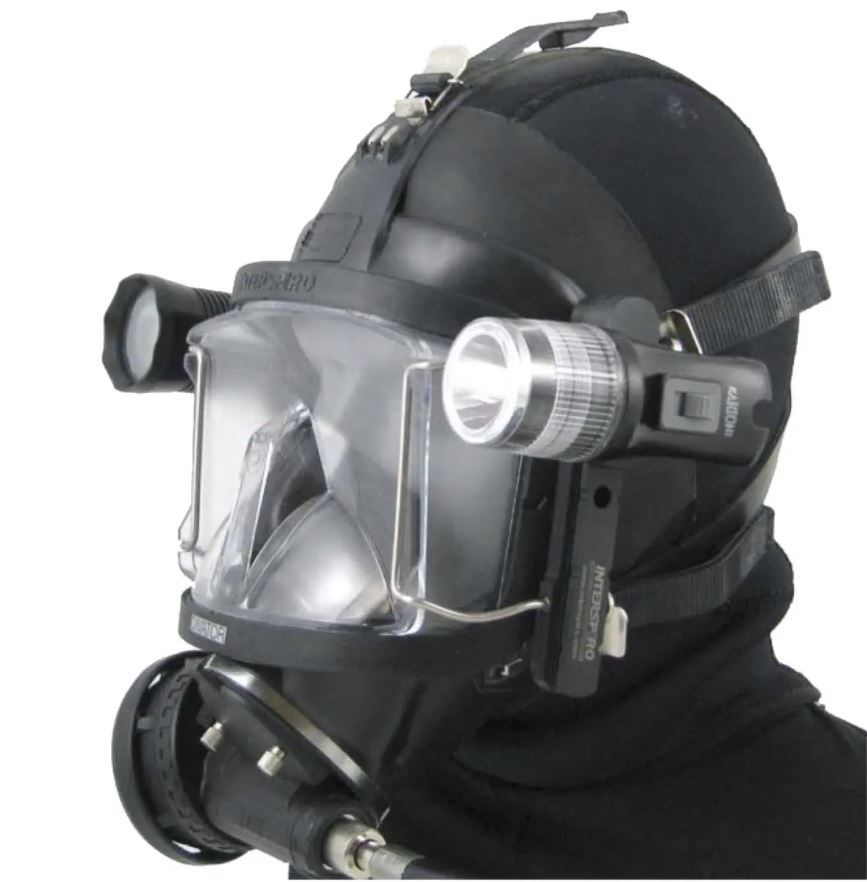Diving with a full face mask has long been the work of various special services, a means of protection used by rescuers and firefighters, working in both smoke and polluted environments and water. In recent years, full face masks have been the exclusive tool used by some select organs. Military, commercially contracted divers, as well as researchers and scientific divers, were among those who succeeded in using this equipment, almost certainly because of its complexity, limited availability, and high cost. Today, however, advances in technology and manufacturing allow these full face masks to be used by sports divers at affordable prices, and we can enjoy the same benefits even though we use full face masks in a much less harsh environment.
Table of Contents
So what is a full face mask?
In a conventional diving device, divers wear a face mask that covers the eyes and nose to relieve pressure in the ears, as well as a separate mouthpiece of the second-level regulator that allows the diver to breathe, while a full face mask combines the two in one device. As a result, there are a number of different considerations for using the mask, some of which can be considered "pros" and others "cons".
Choose a full face mask that suits you
You need to know which properties you are addressing, knowing the conditions under which you think you will use them (as this may also affect the different properties of the mask to look out for), for example if you have frequent movement around the water, you will want to consider a mask with SAV. (DIVATOR Hatch, surface air valve) so you can save the balloon breathing air by breathing atmospheric air, and of course your budget will matter, as they can range from 350 Eur to more than 1500 Eur. No matter how your purchase is made, one thing remains the same - you definitely need to learn how to use a full face mask and receive appropriate training, as there are procedures and considerations you may not be aware of. A PADI full face mask course will address these issues and your instructor will help you become familiar with the proper mask features to dive safely.
Advantages and pros of using a full face mask
The experience described here is largely based on Interspiro Divator MKII and Ocean Reef Neptune type masks with which the author has more than 1000 diving, full face masks.
- No spitting! Huge benefits from a high-end mask such as Divator MKII, there is no blur. These masks use an airflow design that directs cool air inside the mask glass with each inhalation, thus not allowing enough time for the warm face to heat the air and condensate (explained in more detail). Full Face Mask during training).
- Large field of view. Because the mask frame is further away from the eyes / nose, it provides a larger lens and a greater visual angle.
- Reduced jaw fatigue. Since the mask and the regulator are essentially one unit, if they are attached correctly, there is no need to try to waste energy to hold the regulator in your mouth.
- We communicate by talking. Underwater communication systems allow divers to talk to each other. An OTS is a device called a 'friend's phone', which is a receiver and microphone that is attached to a mask and operates using push to talk. These communicators require a line of sight to get the full experience, and can sometimes be a little time consuming, but when working, it can be a great tool when speaking is more valuable than writing on a slate or handwriting.
- Breathing through both the nose and mouth. This feature will seem strange to any experienced diver at first! Ability to inhale through the nose. This is beneficial for anyone involved in adaptive training / experience, offering more normal breathing activities, especially because it is combined with the removal of an oral regulator.
- Safer. There are two ways. First, the regulator. Because it is attached to the mask, the diver is less likely to lose it or accidentally knock it out. And secondly, the mask itself. The strap that holds it in place is not like a regular one-mask strap, it's more like a five-legged spider holding a full face mask in place. One strap under each ear, one strap above each ear and one strap centrally at the top of the head. It can be individually adjusted to the length of each strap, it also allows for personalization and placement.
Full face mask reflections and "cons" that we will look at
- Duration of preparation. Although the safety check before diving does not change, it will take a little longer to put on and put on the mask. You could also dive with a friend who is unfamiliar with the equipment, so you may need to give them a quick overview if you need help diving.
- Respiratory gas management. Here are some factors to consider. Using a full face mask can mean that you use a little more breathable gas while diving, so paying more attention to the SPG (air pressure gauge) is not a bad idea. If you need to clean the mask - partially or completely, the mask will have to release more gas (with the help of a regulator) than you would expect from a regular face mask. The face mask is obviously bigger. In the unlikely event that a diver runs out of air, providing a friend's alternative air source is a slightly different procedure - remember, if you lose gas, then a mask and vice versa, so the correct procedure would always be to dive with a regular mask securely fastened and a working secondary. a breathing apparatus, either a pony bottle or an octopus. Again, with proper training, you will be introduced to these procedures.
- Care. Greater care is required when handling, transporting and installing a full face mask. If you tear the clamping spider, you lose the ability to use the mask and the adjuster. If you break the plexiglass lens, you lose the mask and the regulator.
- Regular maintenance. If you do not do regular full face mask maintenance, you lose the opportunity to use both a diving mask and a breathing regulator.
A mask like Interspiro Divator MKII, to be equipped with various accessories - residual air monitor, light, welding glass holder. Thanks to the anti-fog airflow system, SAV, communication options, adjustable nose plug for easy alignment, and a double mask pressure seal for a comfortable fit and fit to all faces of all sizes. The mask is highly customizable, and you can optionally add accessories - SAV, Gopro mounts, flashlights, etc. - They are also incredibly comfortable and look surprisingly good!
Some manufacturers have created more affordable price ranges at the expense of some full-face mask features. It is possible to use another manufacturer mask, it is at the lower end of the price range and is therefore very affordable, they are designed to allow the diver to insert his second stage regulator, just remove the mouthpiece and insert it into the mask and reattach it inside.
So you can see that there are a number of considerations and many things to consider, so we always recommend that you go through a qualified full face mask instructor before getting a mask and get the right training. One thing is for sure: at the end of the course you will look like a diving professional and hopefully enjoy this unique equipment.
What does the Divator MKII full face underwater mask course teach?
To register Full Face Mask Diver, full face underwater masks for a diver's course, you must have passed PADI Open Water Diver course. We teach with the diver's full face mask Divator MKII Gray, Divator MKII Black DIVATOR Hatch and Ocean Reef Neptune IDM.
There are several types of full face masks, so you will learn more about the different properties and components of a full face mask in the course. You will then learn how to prepare and learn diving techniques with a full face mask, learn how to perform proper maintenance. After several lessons in the water, you will be taught how to comfortably use the mask and practice the necessary skills in preparation for scuba diving.

Learn more about full-face diver masks and apply for training as a PADI instructor Valters Preimanis , coming in two discount 10% (WhatsApp 220-77-202):

